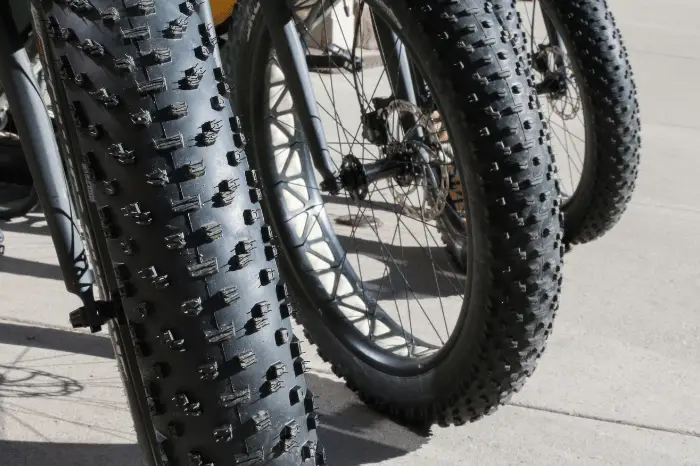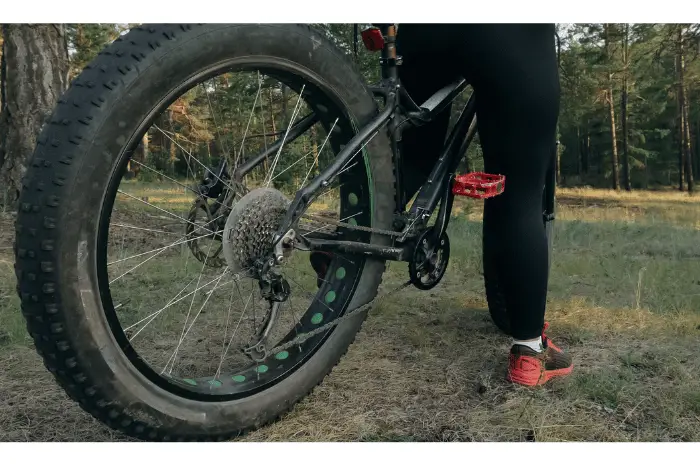
Can you put fat tires on any mountain bike? This is a common question among mountain bikers looking to upgrade their bikes for better traction and stability on various terrains. The answer is yes, you can put fat tires on your mountain bike, but there are several factors to consider before making the switch.
The compatibility of Fat Tires with Standard Mountain Bikes is the first factor to consider when upgrading to fat tires. While fat tires can be put on a mountain bike, the frame and wheels must have enough clearance to accommodate them.
Fat tires are wider than regular mountain bike tires and provide better traction and flotation, making them ideal for riding on soft or loose surfaces like snow, sand, or mud.
However, some standard mountain bikes may not have enough clearance to accommodate fat tires, so it’s important to check the compatibility before making the switch.
Key Takeaways
- Fat tires can be put on a mountain bike, but compatibility must be checked first
- Upgrading to fat tires can provide better traction and stability on various terrains
- Necessary modifications and cost considerations must be taken into account before conversion
Compatibility of Fat Tires with Standard Mountain Bikes
If you are wondering whether you can put fat tires on your standard mountain bike, the answer is yes, but it depends on a few factors.
First, you need to check the compatibility of your bike’s frame and fork with fat tires. Fat tires are wider than regular mountain bike tires, and they require more clearance to fit properly. You need to ensure that your bike has enough clearance to accommodate the wider tires.
Second, you need to check the rim width of your bike. Fat tires require wider rims than regular mountain bike tires to provide adequate support and stability. You need to ensure that your bike’s rims are wide enough to accommodate the wider tires.
Third, you need to consider the type of riding you will be doing with fat tires. Fat tires are designed for riding on soft or loose surfaces like snow, sand, or mud. They provide better traction and flotation on these surfaces, but they also add weight and rolling resistance. If you are planning to ride on hard-packed or smooth surfaces, fat tires may not be the best choice for you.
Finally, you need to consider the brakes on your bike. Fat tires may require adjustments to your bike’s brakes to ensure proper clearance. You need to ensure that your bike’s brakes are compatible with fat tires before installing them.
Benefits of Upgrading to Fat Tires
If you’re wondering whether you can put fat tires on your mountain bike, the answer is yes! But why should you upgrade to fat tires? Here are some benefits to consider:
Better Traction and Stability
Fat tires are wider than regular mountain bike tires, which means they provide better traction and stability on all types of terrain. Whether you’re riding on snow, sand, mud, or loose gravel, fat tires can help you stay upright and in control.
Improved Comfort
Fat tires are also great for improving comfort on your rides. The wider surface area of the tires means that they can absorb more shock and vibration, which can reduce fatigue and make for a more enjoyable ride.
Versatility
With fat tires, you can take your mountain bike on a wider range of adventures. You can tackle soft sand at the beach, ride through snowdrifts in the winter, and explore muddy trails in the spring. Fat tires give you the versatility to ride wherever you want, whenever you want.
Compatibility
Before upgrading to fat tires, it’s important to make sure that your bike is compatible with them. You’ll need to check your bike’s rim width, fork clearance, and potentially adjust your brakes. However, with a bit of knowledge and elbow grease, you can make the switch to fat tires and enjoy all the benefits they have to offer.
Overall, upgrading to fat tires can be a great way to improve your mountain biking experience. With better traction, improved comfort, and greater versatility, fat tires can help you tackle a wider range of terrain and enjoy your rides to the fullest.
Frame and Fork Clearance Requirements

When it comes to putting fat tires on your mountain bike, the most important thing to consider is whether your bike’s frame and fork have enough clearance to accommodate the wider tires. Fat tires are typically wider than regular mountain bike tires, which means they require more space to fit properly.
To determine whether your bike is compatible with fat tires, you should measure the clearance between your frame and fork. The minimum clearance required for most fat tires is around 4 inches (10 cm). If your bike has less than that, you may not be able to fit fat tires without making some modifications to your frame or fork.
It’s important to note that not all mountain bike frames and forks are created equal. Some frames and forks are designed specifically to accommodate fat tires, while others are not. If you’re not sure whether your bike is compatible with fat tires, it’s always a good idea to consult with a professional before making any modifications.
In addition to frame and fork clearance, you should also consider the width of your rims. Fat tires require wider rims than regular mountain bike tires, so if your rims are too narrow, you may not be able to fit fat tires. Most fat tires require rims that are at least 50 mm wide, although some may require even wider rims.
Wheel and Hub Dimensions
When considering putting fat tires on your mountain bike, it’s important to check the compatibility of the wheel and hub dimensions. Fat tires typically have a larger diameter than standard mountain bike tires, so it’s important to ensure that your bike’s wheel and hub dimensions can accommodate the larger size.
First, check the rim width of your mountain bike. Fat tires typically require rims that are wider than those used for standard mountain bike tires. According to Bike Trainer Arena, the rim width should be at least 65mm to 100mm for fat tires.
Next, check the fork clearance of your bike. Fat tires can be wider than standard mountain bike tires, so it’s important to ensure that your bike’s fork has enough clearance to accommodate the larger size. According to Mountain Bikes Lab, you will need at least 3.8 inches of frame clearance for 26-inch tires and at least 4.6 inches of frame clearance for 27.5-inch tires.
Finally, consider the hub dimensions of your mountain bike. Fat tires typically require wider hubs than those used for standard mountain bike tires. According to Bike Destiny, the hub width should be at least 135mm to 197mm for fat tires.
By checking the compatibility of your bike’s wheel and hub dimensions, you can ensure that your mountain bike is capable of accommodating fat tires.
Tire Width and Rim Compatibility
When it comes to putting fat tires on your mountain bike, one of the most important factors to consider is tire width and rim compatibility. Not all tires will fit on all rims, and not all rims are suitable for all tire widths.
First, you need to check the width of your rim. Most mountain bike rims are between 19mm and 29mm wide. According to a tire size chart for bicycle rims, you can use 2.2″ MTB tires on a 20mm inner width rim. However, if you plan to run higher pressure than 40/50psi, MTB tires won’t be able to hold it. So, if you prefer to run with high pressure, and mostly on smooth roads, you should consider using narrower tires.
Second, you need to consider the width of the tire you want to use. Fat tires range from 3.8 to 5 inches wide, and they require wider rims to support them. According to a can I put fat tires on my mountain bike article, you need to ensure compatibility by checking your bike’s rim width, fork clearance, and potentially adjusting brakes.
If you have a narrow rim and want to use a wider tire, you may need to upgrade your rim to ensure compatibility. Alternatively, if you have a wide rim and want to use a narrower tire, you may need to adjust the pressure to avoid damaging the tire or compromising your ride quality.
Impact on Bike Geometry and Handling
When you put fat tires on your mountain bike, it can significantly impact the bike’s geometry and handling. The wider tires increase the overall diameter of the wheel, which raises the bottom bracket height and slackens the head angle. This change in geometry can make your bike feel more stable and provide better traction in certain conditions.
However, the change in geometry can also make your bike feel sluggish and unresponsive. The increased diameter of the wheel can also affect the bike’s overall weight distribution and center of gravity, which can impact the handling of the bike.
It’s important to note that not all mountain bikes are designed to accommodate fat tires. Before making any changes to your bike, it’s crucial to check the manufacturer’s recommendations and consult with a professional bike mechanic.
If you do decide to put fat tires on your mountain bike, it’s essential to adjust the suspension settings to compensate for the changes in geometry and handling. You may also need to adjust your riding technique to account for the differences in traction and stability.
In conclusion, putting fat tires on your mountain bike can have a significant impact on the bike’s geometry and handling. It’s important to consider the manufacturer’s recommendations, consult with a professional bike mechanic, and adjust your riding technique to ensure a safe and enjoyable ride.
Necessary Modifications for Conversion

If you’re interested in converting your mountain bike to a fat tire bike, there are a few necessary modifications you’ll need to make to ensure compatibility. Here are some of the most important modifications to consider:
Wheel Size
Fat tires require wider rims than traditional mountain bike tires. Therefore, you’ll need to ensure that your bike’s wheel size is compatible with the wider rims required for fat tires. Typically, fat tires are designed for 26-inch, 27.5-inch, or 29-inch wheels.
Frame Clearance
Fat tires are wider than traditional mountain bike tires, so you’ll need to ensure that your bike’s frame has enough clearance to accommodate the wider tires. You may also need to adjust your bike’s suspension to prevent the tires from rubbing against the frame.
Drivetrain
Fat tires are heavier than traditional mountain bike tires, so you may need to upgrade your bike’s drivetrain to ensure that it can handle the added weight. This may include upgrading your bike’s chain, cassette, and derailleur.
Brakes
Fat tires require more stopping power than traditional mountain bike tires, so you may need to upgrade your bike’s brakes to ensure that they can handle the added weight and traction of fat tires. This may include upgrading your bike’s brake pads, rotors, and calipers.
Bottom Bracket
Fat tires are wider than traditional mountain bike tires, so you may need to adjust your bike’s bottom bracket to ensure that the wider tires don’t interfere with your bike’s pedals.
By making these necessary modifications, you can convert your mountain bike to a fat tire bike and enjoy the added traction and stability that fat tires provide.
Cost Considerations and Budgeting
When it comes to putting fat tires on your mountain bike, cost is definitely a factor to consider. Fat tires can be more expensive than standard mountain bike tires, and you’ll need to purchase new tires, tubes, and potentially new rims to accommodate the wider tires.
Before making the switch, it’s important to do your research and determine your budget. You don’t want to overspend and end up regretting the decision to switch to fat tires. On the other hand, you don’t want to skimp on quality and end up with tires that don’t perform well or wear out quickly.
One way to save money is to look for deals and discounts. Check with your local bike shop or search online for sales on fat tires. You may also be able to find used fat tires in good condition at a lower price.
Another cost consideration is maintenance. Fat tires require more air pressure than standard mountain bike tires, which means you’ll need a high-volume pump or compressor. Additionally, fat tires can wear out faster than standard tires, especially if you frequently ride on rough terrain. Be prepared to replace your fat tires more frequently than you would with standard tires.
Overall, while cost is a factor to consider when putting fat tires on your mountain bike, it’s important to prioritize quality and performance over price. With the right research and budgeting, you can make the switch to fat tires without breaking the bank.
Maintenance and Upkeep for Fat Tires
If you’re considering putting fat tires on your mountain bike, it’s important to know how to maintain them properly. Fat tires require a bit more care than regular tires, but the payoff is worth it in terms of traction and stability. Here are some tips for maintaining and upkeep for fat tires:
1. Check Your Tire Pressure
Fat tires require lower air pressure than regular tires. The recommended pressure range is usually between 5 and 30 psi, depending on the tire size and your weight. You should check your tire pressure before every ride to ensure that they’re properly inflated. Underinflated tires can cause damage to the rim and make your ride more difficult.
2. Clean Your Tires Regularly
Fat tires are more prone to collecting debris and mud than regular tires. You should clean your tires regularly to prevent damage and prolong their lifespan. Use a soft-bristled brush and mild soap to remove dirt and grime. Avoid using harsh chemicals or high-pressure water, as they can damage the rubber.
3. Rotate Your Tires
Fat tires wear out unevenly, so it’s important to rotate them regularly to ensure even wear. You should rotate your tires every 500-1000 miles, depending on how often you ride. This will help prolong the lifespan of your tires and ensure that they perform optimally.
4. Store Your Bike Properly
When you’re not riding your bike, it’s important to store it properly to prevent damage to your fat tires. Store your bike in a dry, cool place away from direct sunlight. Avoid storing your bike in a damp or humid environment, as this can cause rust and damage to the rubber.
By following these simple tips, you can ensure that your fat tires last longer and perform better. With proper maintenance and upkeep, you can enjoy the benefits of fat tires on any mountain bike.
